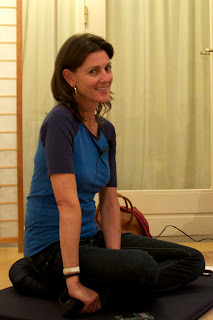
I recently extended my stay in Lerab Ling, the upside of which was that I was able to be here for the visit of Jetsün Khandro Rinpoche. I remember when I first heard Sogyal Rinpoche teach, at the Myall Lakes retreat in Australia many years ago. I had seen some of his teachings before at a Rigpa centre and read a bit of the book (The Tibetan Book of Living and Dying), but I didn't really know what to expect from a live teaching. I was of course completely blown away by his presence and his message. That's how I ended up, much to my surprise, on the other side of the world living in a tent with a view of a Tibetan Buddhist temple.
Since then I have had the immense blessing of receiving teachings from many great masters who had been invited here to Lerab Ling, and each has been an inspiration and illuminated the teachings of the Buddha in a different way. Having said that, not since my first meeting with Sogyal Rinpoche have I been so astounded and invigorated by a teacher as I was after the public talk by Khandro Rinpoche. I had never heard of Khandro Rinpoche before (I'm not very good at knowing names of masters and lineages, I look to my shedra friends for help with that!), and so once again had not known what to expect and was thoroughly wonder-struck. Luckily for me Rigpa Youth would also have the opportunity to interview her.
Jetsün Khandro Rinpoche
The eldest daughter of Kyabje Mindrolling Trichen and the  incarnation of the great Khandro Ugyen Tsomo, she grew up receiving teachings and transmissions from some of the most revered Tibetan masters of our age including Kyabje Mindrolling Trichen, Kyabje Dilgo Khyentse Rinpoche, Kyabje Trulshik Rinpoche and Kyabje Tulku Ugyen Rinpoche. She has been teaching in the West for over seventeen years, has established and heads the Samten Tse Retreat Center in India, and the Lotus Garden Retreat Centre in America. She also heads a variety of charity projects and released a book in 2003 entitled “This Precious Life: Tibetan Buddhist Teachings on the Path to Enlightenment”.
incarnation of the great Khandro Ugyen Tsomo, she grew up receiving teachings and transmissions from some of the most revered Tibetan masters of our age including Kyabje Mindrolling Trichen, Kyabje Dilgo Khyentse Rinpoche, Kyabje Trulshik Rinpoche and Kyabje Tulku Ugyen Rinpoche. She has been teaching in the West for over seventeen years, has established and heads the Samten Tse Retreat Center in India, and the Lotus Garden Retreat Centre in America. She also heads a variety of charity projects and released a book in 2003 entitled “This Precious Life: Tibetan Buddhist Teachings on the Path to Enlightenment”.
My personal impression was that she was clearly a formidable master with a sharp mind, impressively articulate in English, uncompromising in her approach, and with an excellent sense of humour. She was not interested in pretences or outward displays, but in piece by piece dismantling us and uncovering the heart of our being. It was simultaneously thrilling and terrifying.
Both the public talk and our interview were incredibly vast in content, yet inspiringly simple. What I found to be her main message was that the Dharma is at its essence about working with yourself. Not intellectually as we Westerners are prone to do, but courageously and honestly, through self examination and wholeheartedly putting the teachings into practice internally. It sounds obvious when you put it in a sentence like that, but as she described various pitfalls along the path I was surprised at what a little self examination uncovered.
Loyalist Buddhists vs Practising Buddhists
I'm somewhat sheepsih to admit that recently I have been, to use Khandro Rinpoches terms, more of a loyalist Buddhist than a practising Buddhist. That is I have been approaching the Dharma from a fairly intellectual standpoint, unable to deny the truth that resonated with me but unwilling to make any serious changes internally. It turns out this is a common occurrence. As Rinpoche pointed out, we are at an important juncture for Buddhism in the West where it is no longer something new but has been around for generations, and it is no longer sufficient to associate with Buddhism theoretically but, in the words of Khandro Rinpoche “it becomes very important now to actually engage with and experience the teachings as a practitioner”.
As the next generation of Western Buddhists, we have a certain obligation to help maintain the authenticity of Buddhism. But authenticity is not about being or appearing Buddhist, spinning your prayer wheel, doing prostrations, hanging thangkas on your wall or being able to recite scriptures by heart. As Khandro Rinpoche asked us, who would you rather sit next to on a long flight, a very knowledgeable obnoxious Buddhist or a very nice person? It may be rhetorical, but the real question is are we unknowingly on our way to becoming that knowledgeable but obnoxious Buddhist? Are we keeping the Dharma on an appearance level, or are we genuinely and authentically practising it? Not just thinking about it, but practising it. Rinpoche strongly stressed the importance of not becoming 'religious' about the Dharma, not taking it as something that you can just believe in but not integrate.

Khandro Rinpoche urged us to “break free from such a pretentious connection to the Buddha Dharma” and reminded us that the path we are walking on is the path of really working with oneself. She inspired me to re evaluate how I was using the precious teachings that I had received from Sogyal Rinpoche over the years, and to be more honest, courageous and compassionate with myself along the path. In such a short space I am obviously not able to go into great detail about what she taught, such as the importance of a foundation built on contemplation of the four thoughts and the seven points of mind training.
We are already working on a video edit of our Rigpa Youth interview, but in the mean time you can listen to the audio here:
Khandro Rinpoche with Rigpa Youth (mp3)
Those that missed the live streaming can watch the complete public talk:
Compassion Versus Competition: An Essential Teaching on the Buddhist Practice of Lojong
Khandro Rinpoche - Lerab Ling, 1 October 2010



